Mariusz Kotowski
University Press of Kentucky, 2014
“Hollywood’s First Femme Fatale” – and so she was.
She has more than 60 films to her name – in the U.S. and across Europe – and was not just the first foreign star to come to the U.S, but also to become a huge star here.
She was a diva of divas, demanding, expecting – and receiving lavish treatment like fresh flower petals strewn on her dressing room floor daily. A trained ballerina, she was an intense, energetic actress who threw herself (once, quite literally, when she refused to have a stunt double take a fall down a flight of stairs for her) into her roles.
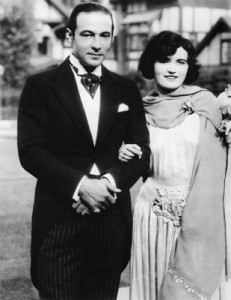
Pola Negri with Rudolph Valentino at the wedding of Mae Murray to Prince David Mdivani in Hollywood, 1926.
Courtesy of Mariusz Kotowski.
And then there were her love affairs – with such Hollywood legends as Charlie Chaplin and an engagement to megastar Rudolph Valentino right before his death. She is not, however, the mysterious Woman in Black who pined at Valentino’s grave for decades on the anniversary of his death, always leaving a single rose (that, it turns out, was a publicity stunt). Besides, Pola wouldn’t have left one paltry rose, but masses of bouquets: At Valentino’s funeral, she sent $2,000 (this was 1926!) blood-red roses with ‘Pola’ spelled out in white blossoms in the middle.
And yet, despite her fame, films, love affairs, megastar status at Paramount Pictures, domination of headlines time and again, she’s not a household name. To film buffs, yes, but to widespread audiences – probably not.
As film historian Charles Silver writes in the foreword of Pola Negri: Hollywood’s First Femme Fatale: “I was well aware… of Negri’s place as one of the major silent stars of the silent period. I came to be surprised, however, by the fact that she seems to have been forgotten by so many people.”
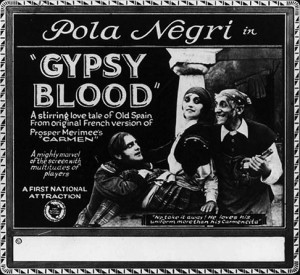
Pola starred in the silent film “Carmencita” in 1918. The film was reissued in 1921 in the U.S. as “Gypsy Blood.” It’s on YouTube in its entirety; here’s part 1.
Mariusz Kotowski’s engaging and fast-paced biography is thus all the more welcome. Kotowski’s mother introduced him to Pola at a young age, though her American films weren’t available in communist Poland where he was born and grew up. When he eventually became a filmmaker, he kept running into Pola – stumbling onto her star at the Chinese Theatre in L.A., looking up at her photo in a New York restaurant, “gazing out at the world with sensuality and command. I couldn’t help but think she was looking straight at me, perhaps challenging me.” The book is a part of his lifelong project to revive the memory of Pola into modern day consciousness. And it’s marvelous – a page-turner in the best sense.
The blossoming art of filmmaking leaps out across the pages. We travel with Pola from Poland and her beginnings as a ballet dancer and theatre star to Germany, where the silent movie era has just begun. “The silent era was, of course the beginning of the invention of a new language—the language of film,” Kotowski writes. She was there for those beginnings, and film became a perfect vehicle to showcase her vitality, sexuality and the intense passion she brought to all her roles.

“Forbidden Paradise” (1924) was an American silent film drama directed by Ernst Lubitsch, produced by Famous Players-Lasky and distributed by Paramount Pictures. Here’s a tiny little clip on YouTube.
Poster image courtesy of Mariusz Kotowski.
After conquering the German film world, she was brought to Hollywood by Paramount. Her New York arrival via ocean liner was welcomed by crowds and made New York Times headlines: “Polish Film Star to Appear in Series of Paramount Pictures.”
Hollywood too, was just beginning. A “small film-production town where the people, not the buildings, were the center of events.” Pola, Kotowski writes, “had a lot of growing up to do, but so did Hollywood.” They did so together: through the growing pains of the Hays Office very first dictate limiting the showing of sexual content on screen to restrictions on her creative and even personal life. Stars were expected to live up to puritanical standards of ethical behavior, though most most certainly did not in those Roaring Twenties – filled with illicit boozing, parties, love affairs, drugs, murders.
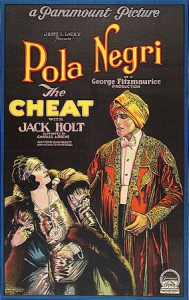
The silent film “The Cheat” (1923) is a remake of Cecil B. DeMille’s 1915 hit using the same script. This one starred Pola Negri, draped in fur and jewels in the film poster. She’s being grabbed by Charles de Roche, who’s dressed as an Indian prince. This version was produced by Famous Players-Lasky and distributed by Paramount Pictures.
She conquered Hollywood as she had her former homeland Poland and the extensive German film world, and even though “Pola wasn’t always happy with the movies she was in… each of them brought her money and fame.”
Then, in 1927, came the talkies, and a new era. “She had created an image that was locked into her decade,” Kotowski writes, and quotes film historian Jeanine Basinger:
“They just wanted new stars, different stars, and Pola was associated with something more eloquent, something glamorous in the 1920s tradition. That decade of stardom is very different from the thirties…”
Another reason for her box-office slump? Her engagement to Prince Serge Mdivani six months after Rudolph Valentino’s funeral – at which Pola was front and center, swaying on her feet, veiled in black, though she was also highly criticized for the way she’d acted, “accused of showing too much and behaving falsely.”
Despite the Mdivani engagement, Kotowski writes, “Nobody could take Valentino’s place… She had other kinds of love after that, but she was never again to experience the passion that she and Valentino shared.”
Perhaps something within Pola broke after Valentino’s death; perhaps she only thought it did (which really amounts to the same). She married the Prince, then divorced. “[W]eary and mentally exhausted,” she was no longer making four to five films a year.
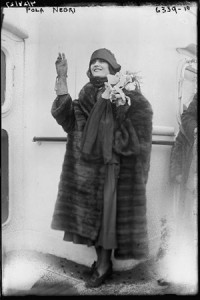
The Library of Congress lists this image of Pola Negri as undated, but in the top left, “4/28/27” is written in visible in reverse. P.S. Look at that fur coat.
It seems the perfect storm: her undoubted depression and despair after Valentino’s death; the fickle public’s judgment of her over-the-top emotional displays at his funeral AND a new engagement just half a year later; sound in film and her thick foreign accent; and Hollywood’s constant need for new and fresh faces.
Pola did work on a transition to talkies. First on stage, at London’s famous Coliseum. But “[a]lthough the shows were sold out and the audiences rose to their feet each night, when the reviews came, they were not altogether favorable for either the one-act play or for Negri herself,” Kotowski writes. Still, Dietrich and Garbo were now on talking screens with foreign accents, so “Why not Pola?” mused Motion Picture Magazine in 1931.
Her first talkie, “A Woman Commands,” (1932) was beset with production problems, and Pola with health problems. She was well received once the film finally came out, but her performance “could not offset the movie’s shortcomings,” Kotowski writes. This too seems a running theme in her Hollywood career that contributed to her eventual decline – roles for which she was ill-suited; poor direction; lackluster scripts.
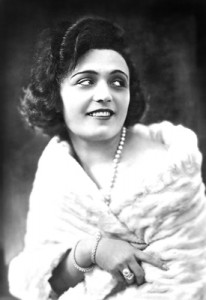
A 1916 Pola Negri publicity picture from Warsaw.
Courtesy of Mariusz Kotowski.
She went on to make other talkies: “Mazurka” with UFO in Germany in 1935, called “the best German talkie ever by critics,” but she was first pilloried by the German Propaganda Ministry for having a Jewish secretary, Jewish contacts, and a Slavic father. After interventions by the Polish Ambassador in Berlin and NYT news reports, Chancellor Hitler himself signed permission for her to work in Germany. She made more films in Germany, through 1938, with more and more restrictions and censorship, and then left as Germany primed itself war.
The fact that she’d worked in Germany in the 1930s became another topic of negative tablet fodder, especially reports that she was Hitler’s favorite actress. She defended her decision: She wanted to act, make art, desperately needed money after her disastrous financial hit following the Mdivani divorce and the stock market crash of 1929. So when she returned to the States, she was “suspected of collaborating with the enemy, although she was never formally charged,” Kotowski writes.

Pola’s 1951 U.S. naturalization certificate. Note the fake date of birth – Dec. 31, 1899. She was born Jan. 3, 1897, as Barbara Apolonia Chalupec, but in later years, writes Kotowski, “claimed the last day of the century… as her birthday.” Part of that was no doubt shaving a few years off, but the “last day of the century” bit undoubtedly must have appealed to her innate sense of drama.
Before she’d left for Germany, she’d made an American talkie: “Hi Diddle Diddle.” It was a comedy, a parody in which she played a “stylish, temperamental opera singer.” Once back in the States, she received offers for more roles like that, but turned them down, wanting meatier, more ambitious ones.
She got that kind of offer in 1950 – and inexplicably, turned it down. This, perhaps, may have been the final and proverbial nail in her career coffin.
Billy Wilder approached her to read for the part of Norma Desmond in “Sunset Boulevard.” The part was modeled on a combo of actresses – but, according to Jeanine Basinger, Desmond’s outrageous ego was “most likely” Pola’s.
The part was different when first written, and both Mary Pickford and Mae West had turned it down. Kotowski defends Pola’s decision: “Negri knew the story—as then written—and the casting would not be right with her…Negri was comfortable financially and did not feel obligated to take the role of Desmond, a reclusive, bitter, and eccentric actress.”
I disagree. “Sunset” is easily one of my top favorite films and I adore it all – from swimming pool beginning to chilling end. But can you imagine Pola slinking down that curved staircase in the final scene, bejeweled, veiled, and uttering those immortal words: “All right, Mr. DeMille, I’m ready for my close-up”?
I can. And I wish she had.
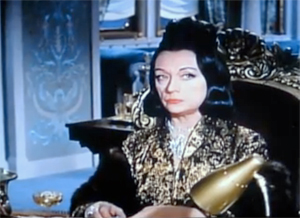
Pola’s final film role: Madame Habib in “Moon Spinners,” 1963. Pet leopard not included.
Her last movie was the 1963 American “Moon Spinners.” Finally, the world could see and hear her in full color and sound. Which means that I could too! Many wonderful photos adorn Kotowski’s book, but I longed to see her beyond blacks and whites and grays.
Parts of the film are on YouTube. She plays Madame Habib, a jewel thief, and is simply imperial. Her eyes are mesmerizing: dark, deep, hyper-attentive, missing nothing. Yes, the accent is there, and one imagines lesser actresses faking this deliciously low alto as she spouts lines like, “And you know who I am? I’m the March Hare!” There’s a leopard in the room too, Madame Habib’s pet – but Pola is fiercer.
“Everybody lies when it serves their purpose,” Pola à la Madame Habib declares. “Even the stars.” She’s talking about the physical stars in the sky – but how fitting that star is one of the last words she ever said on film.
CR





Pingback: Welcome to our Summer 2014 issue!
i would like to see Alla Nazimova in a film she seemed so over driatamc! You should see her in Salome from 1923 — it was a, well, let’s say interesting attempt to film Oscar Wilde’s play about the dancer who insisted King Herod cut off John the Baptist’s head. Nazimova was 42 playing a teenager, she’s completely over-the-top and as a narrative, the movie doesn’t work at all, but she has an undeniable presence on the screen. It was one of those experiments that I can’t say really worked, but you can’t take your eyes off her.
Hi there,
Pola Negri’s birthday was January 3, 1897, according to her Polish birth certificate
http://polanegri.pl/templates/polanegrijoomla/polagaleria/obraz0001.jpg
I had the pleasure of meeting her in about 1976 at The Beverly Wilshire Hotel. I had a friend who was a bell boy there and he informed she had just checked in with her husband. I went to my favorite memorabilia shop on Hollywood Blvd. and then to the hotel where I waited until they came out of the restaurant. I addressed her and she was surprised but most responsive and charming. Her husband and other gentleman stepped aside and continued their conversation allowing Pola and I a few minutes to talk. SHe was still lovely and animated dressed in a gray wool suit with a fox stole. She signed he photo and acted amazed that someone my age even knew who she was. I admitted I had not been lucky enough at that time to have seen any of her films except Moonspinners, but I thought she was one of the loveliest of the stars in her many stills. She thanked me and I left . A very memorable few minutes for me. I still have the picture framed in my art studio. That started a collection I have built on for 44 years.
What a beautiful anecdote! Thank you for sharing.
Robert Gooding,
Thank you for sharing this wonderful recollection. I bet you really made her day!